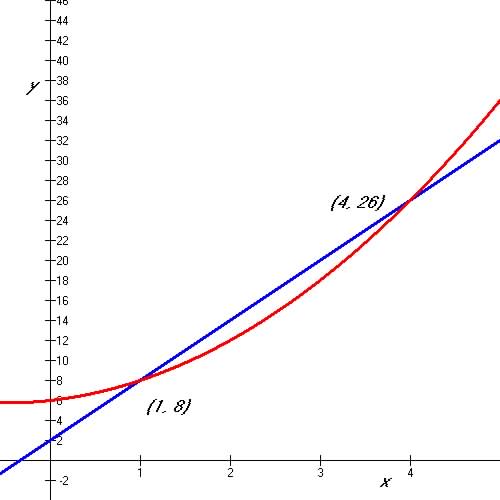Mix
Models
In this text we will explore problems when two or more functions intersect
with each other.
The simplest form is the intersection of two linear functions or the
intersection of a linear function with a quadratic function. Often its
is necessary to determine the points where the graphs of both function
intersects or crosses each other.
In some cases finding the point(s) where two functions intersect can
be an algebraic solution and in other cases one must use a graphical method
to find the solution(s).
Example 3. Find the point where the these two functions intersect:
y
= 3x -2 and y = -2x + 8
Finding Point(s) of Intersections of Functions - Algebraic Approach
To find the point(s) where two functions intersect first set the functions
equal to each other and solve for x and then substitute x
into any of the equation and solve for y. There are other ways of doing
this algebraically, can you think of another?
So set y = 3x - 2 = -2x + 8
3x -2 = -2x + 8
Group like terms: 3x + 2x = 8 + 2 = 5x = 10 or x = 2
Substitute x = 2 into y = 3x - 2 = 3(2) - 2 = 6 - 2 = 4
So point of intersection is (x, y) = (2,
4)
Finding Point(s) of Intersections of Functions - Graphical Approach
If you plot both functions on the same axis and use the [ISECT]
function to find the point of intersection,
then you have found a graphical solution to the problem:
The [ISECT] function is found under the [Graph] Menu and
will be demonstrated in class.
Therefore a graphical solution to the problem in Example 3 is:
Figure 2.8 Graphical Solution to Simultaneous Linear Functions:
y = 3x -2 and y = -2x + 8
Example 4. Find the points where the following two functions
intersect:  and
and 
Table 2.4 Intersection of two Curves: Algebraic and Graphical Solutions
| Algebraic Solution:
Set equation equal to each other:

Move all to right: 

So when y = 0, x = 1 and 4
From y = 6x +2, when x = 1 and 4 we have:
(1, 8) and (4, 26) |
Graphical Solution: Figure 2.9

|
|